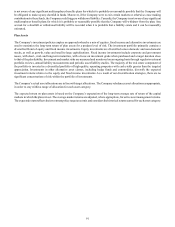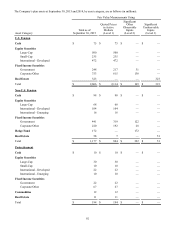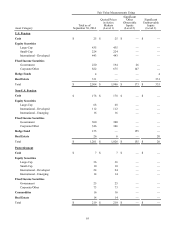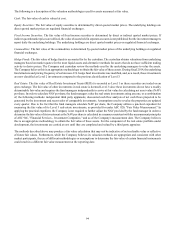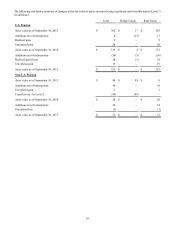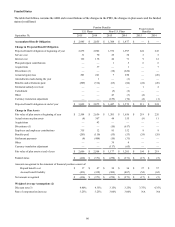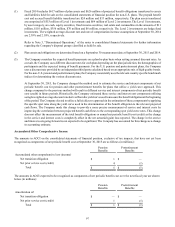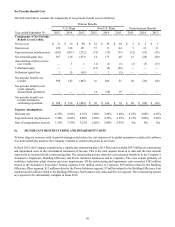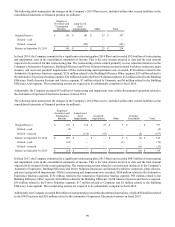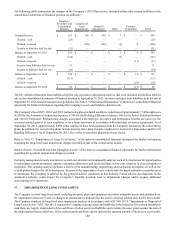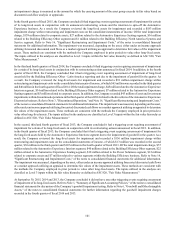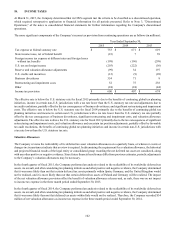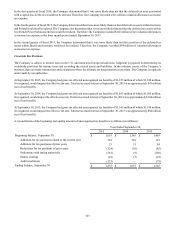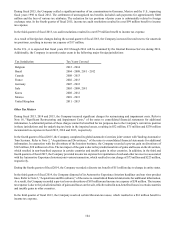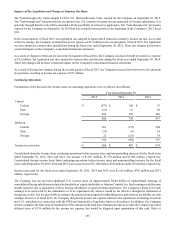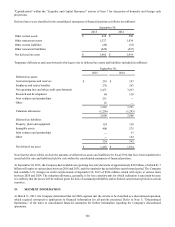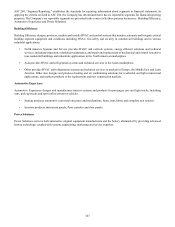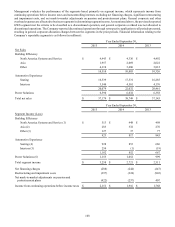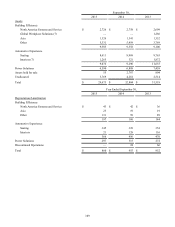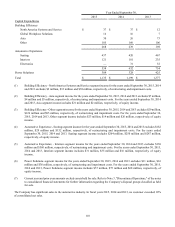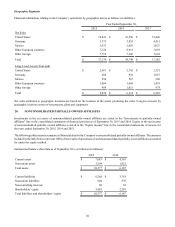Johnson Controls 2015 Annual Report Download - page 101
Download and view the complete annual report
Please find page 101 of the 2015 Johnson Controls annual report below. You can navigate through the pages in the report by either clicking on the pages listed below, or by using the keyword search tool below to find specific information within the annual report.101
an impairment charge is measured as the amount by which the carrying amount of the asset group exceeds its fair value based on
discounted cash flow analysis or appraisals.
In the fourth quarter of fiscal 2015, the Company concluded it had triggering events requiring assessment of impairment for certain
of its long-lived assets in conjunction with its announced restructuring actions and the intention to spin-off the Automotive
Experience business. As a result, the Company reviewed the long-lived assets for impairment and recorded a $183 million
impairment charge within restructuring and impairment costs on the consolidated statements of income. Of the total impairment
charge, $139 million related to corporate assets, $27 million related to the Automotive Experience Seating segment, $16 million
related to the Building Efficiency Other segment and $1 million related to the Building Efficiency North America Systems and
Service segment. Refer to Note 16, "Significant Restructuring and Impairment Costs," of the notes to consolidated financial
statements for additional information. The impairment was measured, depending on the asset, either under an income approach
utilizing forecasted discounted cash flows or a market approach utilizing an appraisal to determine fair values of the impairment
assets. These methods are consistent with the methods the Company employed in prior periods to value other long-lived assets.
The inputs utilized in the analyses are classified as Level 3 inputs within the fair value hierarchy as defined in ASC 820, "Fair
Value Measurement."
In the third and fourth quarters of fiscal 2014, the Company concluded it had triggering events requiring assessment of impairment
for certain of its long-lived assets in conjunction with its restructuring actions announced in fiscal 2014. In addition, in the fourth
quarter of fiscal 2014, the Company concluded that it had a triggering event requiring assessment of impairment of long-lived
assets held by the Building Efficiency Other - Latin America reporting unit due to the impairment of goodwill in the quarter. As
a result, the Company reviewed the long-lived assets for impairment and recorded a $91 million impairment charge within
restructuring and impairment costs on the consolidated statements of income, of which $45 million was recorded in the third quarter
and $46 million in the fourth quarter of fiscal 2014. Of the total impairment charge, $45 million related to the Automotive Experience
Interiors segment, $34 million related to the Building Efficiency Other segment, $7 million related to the Automotive Experience
Seating segment and $5 million related to corporate assets. In addition, the Company recorded $43 million of asset and investment
impairments within discontinued operations in the third quarter of fiscal 2014 related to the divestiture of the Automotive Experience
Electronics business. Refer to Note 3, "Discontinued Operations," and Note 16, "Significant Restructuring and Impairment Costs,"
of the notes to consolidated financial statements for additional information. The impairment was measured, depending on the asset,
either under an income approach utilizing forecasted discounted cash flows or a market approach utilizing an appraisal to determine
fair values of the impairment assets. These methods are consistent with the methods the Company employed in prior periods to
value other long-lived assets. The inputs utilized in the analyses are classified as Level 3 inputs within the fair value hierarchy as
defined in ASC 820, "Fair Value Measurement."
In the second, third and fourth quarters of fiscal 2013, the Company concluded it had a triggering event requiring assessment of
impairment for certain of its long-lived assets in conjunction with its restructuring actions announced in fiscal 2013. In addition,
in the fourth quarter of fiscal 2013, the Company concluded that it had a triggering event requiring assessment of impairment for
the long-lived assets held by the Automotive Experience Interiors segment due to the impairment of goodwill in the quarter. As a
result, the Company reviewed the long-lived assets for impairment and recorded a $156 million impairment charge within
restructuring and impairment costs on the consolidated statements of income, of which $13 million was recorded in the second
quarter, $36 million in the third quarter and $107 million in the fourth quarter of fiscal 2013. Of the total impairment charge, $57
million related to the Automotive Experience Interiors segment, $40 million related to the Building Efficiency Other segment, $22
million related to the Automotive Experience Seating segment, $18 million related to the Power Solutions segment, $12 million
related to corporate assets and $7 million related to various segments within the Building Efficiency business. Refer to Note 16,
"Significant Restructuring and Impairment Costs," of the notes to consolidated financial statements for additional information.
The impairment was measured, depending on the asset, either under an income approach utilizing forecasted discounted cash flows
or a market approach utilizing an appraisal to determine fair values of the impairment assets. These methods are consistent with
the methods the Company employed in prior periods to value other long-lived assets. The inputs utilized in the analyses are
classified as Level 3 inputs within the fair value hierarchy as defined in ASC 820, "Fair Value Measurement."
At September 30, 2015, 2014 and 2013, the Company concluded it did not have any other triggering events requiring assessment
of impairment of its long-lived assets. Refer to Note 1, "Summary of Significant Accounting Policies," of the notes to consolidated
financial statements for discussion of the Company’s goodwill impairment testing. Refer to Note 6, "Goodwill and Other Intangible
Assets," of the notes to consolidated financial statements for further information regarding the goodwill impairment charges
recorded in the fourth quarter of fiscal 2014 and 2013.


